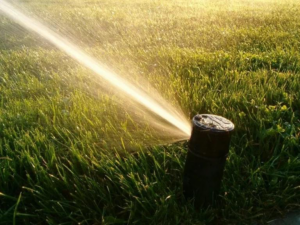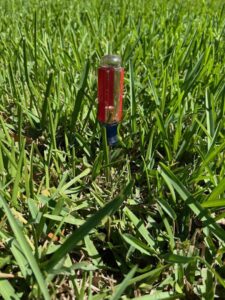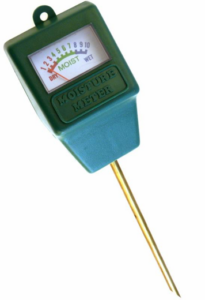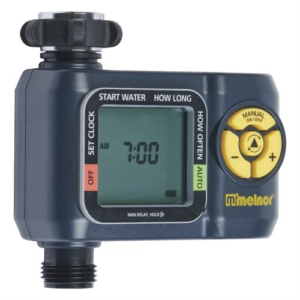Watering is one of the trickiest parts of lawn care because each lawn has different needs depending on conditions of the lawn (ie. shade, soil type, grading of lawn) and sometimes different areas in the SAME lawn have different needs. Too little water? Brown grass. Too much water? Fungus stress. In general though, grass needs at least 1 inch of water per week (even if it had 5 inches a few weeks ago, most soils hold less than 7 days of moisture) in order to stay green and out of dormancy.

WATER IN THE MORNING
Why? The air is cooler, the ground is cooler, the grass is cooler, winds are lighter and the sun is not as strong. This reduces evaporation and improves absorption into the soil where it is really needed, at the grass roots
WATER DEEP AND LESS OFTEN

Water to soak the ground 3-4 inches deep each time you water. That may mean 30 minutes per area each time in sandy soil or 60 minutes per area in clay soil. DO NOT WATER EVERY DAY, 2-3 times a week should be sufficient depending on weather conditions. If you don’t know if you are watering long enough, it’s easy to check:
- Water the lawn
- When done watering, take a long screwdriver and jam it into the ground 4-5 inches deep
- Move it left to right to make a small hole
- Is the soil moist at least 4 inches deep? If so, that is how long you need to water for. If not, water again until the water reaches 4-5 inches deep
- Don’t have time for this? Read on!
Why should you not water every day for short periods? This is almost more damaging than not watering at all. Short watering causes shallow rooting of the grass plants and does not reach the root zone where it is needed and leaves the blades wet which can cause fungus.
USE A MOISTURE METER

Don’t have a screwdriver or the time to go digging holes all over the yard? Buy a moisture meter! Anyone can use it, just stick it into the ground and it will tell you if it is dry or wet in that area. These can be found at home improvement stores and identify areas that need more or less water.
DO NOT WATER AT NIGHT
Lawns need water at their roots. By watering at night, you get the blade wet and it stays wet all night until the sun evaporates the water the next day. The lasting moisture on the blade encourages fungus growth. If you have no other option, water very heavy one evening and then do not water for a few days.

USE A WATER TIMER
Many people say they don’t have time to water because they are busy and can’t get back to turn off the water. Good thing they sell a tool to help with just that! A water timer works just like a lamp timer. They attach at the spigot, you set how long you want it to run for, and it shuts itself off! You can get them at most home improvement stores and cost between $10-$25.
WHAT HAPPENS IF I DON’T WATER?
If you choose not to water, the lawn will go dormant. This is a natural process that helps the lawn protect itself from the heat and lack of water. When soil temperatures get above 90 degrees, grass goes into survival mode. The plants first close up the stomata (opening cells along the leaves) which makes the lawn look thinner. Next, they draw moisture back into the crown of the turf, which makes the grass blades turn brown. This does not mean the grass is dead. If the lawn goes dormant, make sure that you:
• DO NOT MOW-if your lawn is going dormant it is not growing and does not need to be mowed!
• Minimize all traffic on the lawn. No jumpy things, no kiddie pools, no slip-n-slides, all of these will amplify the heat underneath them and will stress the lawn even more.
When a lawn suffers drought, some areas may thin out as the plants all fight for soil moisture. Typically when the rain returns, most areas will recover if they were not abused too much during the drought. However, if the lawn goes too long without water, it will die and need to be reseeded. Even in dormancy, grass plants need 1/4 inch of water a MONTH to keep the crown of the plant alive.

